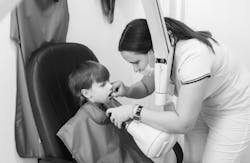Thursday Troubleshooter: Insurance companies ‘downcode’ and confuse dental practice
Nearly everyone has problems and concerns on the job, and sometimes you're just too close to a situation to solve something yourself. Share your concerns with Team Troubleshooter, and the experts will examine the issues and provide guidance. Send questions to [email protected].
__________________________________________________________________________________________________________________________________________
QUESTION: I’m very confused about some coding issues. Our usual treatment plan for a new patient is D0999 (sterilization), D0150 (comprehensive), D0274 (bitewings), and D0330 (panoramic x-ray). I know this can’t be correct. Some of the insurance companies we deal with are downgrading to D0210 (full mouth x-rays). Aren’t panos extraoral? I thought fmx’s were intraoral. Please help!
ANSWER FROM PATTI DIGANGI, coauthor of the “DentalCodeology" series of books:
Thank you for your question. Confusion can reign when it comes to coding. There are several issues of concern in your question.
If D0330 panoramic radiographic image and D0274 bitewings, four radiographic images, are the accurate codes, then that is correct. (Please note: the codes are listed as they appear in CDT 2017 and are the only correct codes.) A practice must use the codes that most accurately describe the procedures completed. To change or use a code for the purpose of increasing benefits can be considered fraud.
As Dr. Charles Blair states in Coding with Confidence, “Dental fraud is any crime where an individual receives insurance money for filing a false claim, inflating a claim, or billing for services not rendered. Fraud is sometimes called the ‘hidden’ crime because we are all victims without even noticing it.”
What the carrier has done is remap those codes to D0210 intraoral—complete series of radiographic images.Remapping is the current word used by carriers for what has traditionally been called down-coding.
The question often comes up, “Why can a carrier remap (down-code) but a practice cannot?” When a carrier remaps, it is based on a contract and finances. When an office remaps (down-codes) it’s saying it performed a different procedure. That change can be considered fraud, whether it’s from ignorance or by accident.
The next part to consider is your new patient protocol. The general description in CDT for radiographic images states, “ . . . should be taken only for clinical reasons as determined by the patient’s dentist.”Diagnostic images should be ordered by the dentist based on the patient evaluation. The evaluation therefore needs to come before the images are taken.
One-size-fits-all parameters are easy to administer. But with the wide variety of needs, conditions, and circumstances that can be encountered with new patients, one-size-fits-all may not be the best choice. Benefit carriers, through utilization review, have started to ask for documentation of the reasons and results for images. If there is no reason or result documented, claims are not paid. There have been occasions where practices had to return money for previously paid claims.
Finally, there is an excellent new online CE course called Dose Creep in Dental Radiology written by Cindy Saylors, MEd, and Catherine Warren, RDH. I think it is a must read for dental professionals who take radiographic images. It should give us all pause on the why, when, and how much when it comes to patients’ radiation exposure.
RECENT TROUBLESHOOTERS
Dental hygienist tired of handling majority of difficult patients
Extremely heavy tartar coding
How to correctly charge for difficult patient requests?
Don't be shy! If YOU have a tough issue in your dental office that you would like addressed, send it to [email protected] for the experts to answer. Remember, you'll be helping others who share the same issue. Responses will come from various dental consultants, as well as other experts in the areas of human resources, coding, front office management, and more. These folks will assist dental professionals with their problems on DentistryIQ because they're very familiar with the tough challenges day-to-day practice can bring. All inquiries will be answered anonymously each Thursday here on DIQ.





